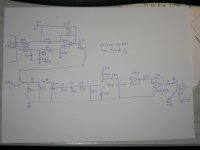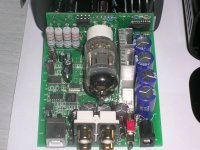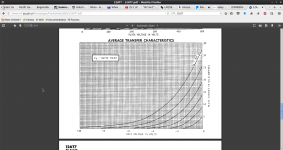A long time ago I replaced in my phono stage high priced Siemenc E88CC with much cheaper Ei PCC 88 and it made a big improvement in sound-more neutral and precise sound. I had to increase heater voltage for PCC valve.
There are some possibilities I can think of.
1. The sound signature of the Ei PCC88 matched better with your system than the Siemens one.
2. Is the Siemens one authentic? Check for stamped shiny metal plaques inside the bulb.
3. Too different working regimes - different plate currents/voltages/Rp
Number 3 should be checked first.
Some time ago I tried to make a differential amplifier using a double pentode compactron tube. The data sheet clearly say "twin pentode", not "dual dissimilar pentode". When trying to balance the plate voltages, it was impossible. Then, after some tests, I wire together cathodes, grids, screens and suppressors, wired to proper voltages. Only plates were maintained separately, tied to EBB with two matched resistors. Surprise: one section draws 3 times the current than the other.
I imagine that if such a dissimilar characteristics in two tubes in the same envelope, why not still bigger ones in differents brands...
I imagine that if such a dissimilar characteristics in two tubes in the same envelope, why not still bigger ones in differents brands...
Attachments
Curve tracing will often reveal some differences, and an amplifier test circuit with FFT often will show very significant differences in total distortion and the harmonic make up of that distortion.
My vote too. I often saw dramatically different distortion spectra between samples and manufacturers. My recollection is manufacturers clustered around different means, even if sample variation still created wide overlaps between manufacturers.
I believe that the reason people say some tubes sound better than others is due to manufacturing tolerances. The companies which people say sound better probably had much tighter tolerances when making tubes, ensuring that every tube produced a reliable, consistent sound. This could also contribute to Osvaldo's observation, that the two pentodes in the tube were different.
carbon plates... IMHO, chinese carbon purity is not enoughSome makes of Tubes certainly last much longer than others; One of my friends used Russian 811A's in his amps for close to 20 years Still measured as new; then he tried Chinese 572B's after 18 moths they were as good as dead. I have heard of USA made 805's lasting for 20+ years in transmitters; Must just be better materials.
A few months ago I was listening to changes in sound while changing a tube in a friend’s headphone amplifier.
I was surprised and I started measuring DC voltages at the pins of the tube socket.

George
I was surprised and I started measuring DC voltages at the pins of the tube socket.

George
Attachments
George, this effect box as if was designed for such troubles. 
You can see form of curves for 12AT7 on such voltages and currents. Slight changes of values of resistors in anode and cathode would change the sound even more. No surprise here!
You can see form of curves for 12AT7 on such voltages and currents. Slight changes of values of resistors in anode and cathode would change the sound even more. No surprise here!
Attachments
A few months ago I was listening to changes in sound while changing a tube in a friend’s headphone amplifier.
I was surprised and I started measuring DC voltages at the pins of the tube socket.
George
Very interesting, George. Were you able to draw a y conclusions between what you measured and what you heard?
Its not all about a change in technical parameters or voltage only. This may be true and the tubes have small variations on parameters of the same type, too.
But the main reason why tubes sound different on the same type is the use of materials and the production process of the tubes. Its all audible. So we have to ask, for example: why is Western Electric still no longer able to produce their famous and expensive 300B tubes? Fact is, everyone who manages to produce a power triode of that quality WE did in ancient times could make a fortune with it. After WE stopped its original production in 1988 nobody managed to replicate the sound of the originals. Even the new Western Electric original 300B tubes sounded different. But they had some of the original retired staff working on this project and the original machinery. But maybe they couldnt manage to buy the original raw materials as those suppliers ceased production long ago?
So to me its all in the close specs, the best materials and the correct production process with masses of tubes produced so you can produce selected ones. The low output of production nowadays and the materials are no longer as good as they were. And they are no longer working to such high standards as the major companies did. Maybe the workers are not so experienced, thats too is often the reason for bad production quality and short life of tubes.
But the main reason why tubes sound different on the same type is the use of materials and the production process of the tubes. Its all audible. So we have to ask, for example: why is Western Electric still no longer able to produce their famous and expensive 300B tubes? Fact is, everyone who manages to produce a power triode of that quality WE did in ancient times could make a fortune with it. After WE stopped its original production in 1988 nobody managed to replicate the sound of the originals. Even the new Western Electric original 300B tubes sounded different. But they had some of the original retired staff working on this project and the original machinery. But maybe they couldnt manage to buy the original raw materials as those suppliers ceased production long ago?
So to me its all in the close specs, the best materials and the correct production process with masses of tubes produced so you can produce selected ones. The low output of production nowadays and the materials are no longer as good as they were. And they are no longer working to such high standards as the major companies did. Maybe the workers are not so experienced, thats too is often the reason for bad production quality and short life of tubes.
Some time ago I tried to make a differential amplifier using a double pentode compactron tube. The data sheet clearly say "twin pentode", not "dual dissimilar pentode". When trying to balance the plate voltages, it was impossible. Then, after some tests, I wire together cathodes, grids, screens and suppressors, wired to proper voltages. Only plates were maintained separately, tied to EBB with two matched resistors. Surprise: one section draws 3 times the current than the other.
That's exactly what Morgan Jones reports on 6SN7's in the 3rd edition of his Valve Amplifiers book. Hence he recommends pairing from some batch of individual 6J5 triodes.
So to me its all in the close specs, the best materials and the correct production process with masses of tubes produced so you can produce selected ones. The low output of production nowadays and the materials are no longer as good as they were. And they are no longer working to such high standards as the major companies did. Maybe the workers are not so experienced, thats too is often the reason for bad production quality and short life of tubes.
You've hit the nail, I think. In the tube heydays, when they were a mass product, manufacturers simply took more care on a product, especially as it was hand-made in the essential (with respect to the outcome) production steps.
Best regards!
I agree that tube *envelopes* are consistently different by Brand and can be reliably trusted to tell one from the other.Some brands have their "mark seals" and are difficult/impossible to be copied. For example, Telefunken noval tubes have their trademark logo stamped in the glass during manufacture, while it being in a soft state. Philips tubes have marks etched on their glass bulb. Siemens tubes have an inner metal plaque with the date manufacture stamped on them.
Now "sound"?
Even, as mentioned above, inside the same glass envelope
Some time ago I tried to make a differential amplifier using a double pentode compactron tube. The data sheet clearly say "twin pentode", not "dual dissimilar pentode". When trying to balance the plate voltages, it was impossible. Then, after some tests, I wire together cathodes, grids, screens and suppressors, wired to proper voltages. Only plates were maintained separately, tied to EBB with two matched resistors. Surprise: one section draws 3 times the current than the other.
I imagine that if such a dissimilar characteristics in two tubes in the same envelope, why not still bigger ones in differents brands...
The A No. One problem with trying to do that is these dual pents were intended to make two stage IF amp cascades, not differential amps. Attention to balance wasn't an important consideration, and so wasn't maintained. Being that out of balance was of no consequence when used for its intended purpose.
I used 8BN11 in several amps. However, not as LTP, but as drivers for 2 separate channels. Very nice tube! Yes, dissimilarities are like when you use 2 separate pentodes from the same batch, but so what? Nothing is precise in the nature.
Also, I used in LTP driver stages a QQE03/12 designed for UHF PP amps. And they required to balance bias between halves, even though used different sides of the same cathode!
Also, I used in LTP driver stages a QQE03/12 designed for UHF PP amps. And they required to balance bias between halves, even though used different sides of the same cathode!
I just swapped out my Preamp tubes today, What a difference.
My amp came with cheap made in China tubes in the preamp.
I stuck in a new pair of 12AU7 tubes and gave it a listen and
it sounds far better, I went on to put the new powere tubes in
but the biggest change was with just new preamp tubes.
So Yes there is a definite difference in tube manufactures.
My amp came with cheap made in China tubes in the preamp.
I stuck in a new pair of 12AU7 tubes and gave it a listen and
it sounds far better, I went on to put the new powere tubes in
but the biggest change was with just new preamp tubes.
So Yes there is a definite difference in tube manufactures.
A few months ago I picked up a used VTA SP9 preamp, uses 4X 12AX7 tubes and it came loaded with JJ tubes. I had listened to it on some Dynaco speakers at the sellers house. Sounded fairly good. Got it home and put it into my system, CDP to VTA SP9 to my Mac MC40's and than into my Altec's. Put on some Dire Straits and 15 seconds later shut it off, it was terrible. Altec's are unforgiving of any weak link. Pulled the JJ's, put Telefunkins in the back position and some NOS Sylvania's JAN 12AX7WA in the front position. Wow, major upgrade to my SS preamp. I was hearing instruments that were just a blend before, now I could hear each individual one. Never been impressed with JJ tubes and this time they really sucked. So yes, there is a big difference in the performance and sound of tubes.
BillWojo
BillWojo
Tube spec tolerances are loose. At least 10% and I suspect significantly more in some cases. If you roll tubes without re-optimizing bias for each tube, using an oscilloscope, then tubes may sound different because of the way they clip due to bias variations.
Asymmetric clipping will bring out more even harmonic distortion, the 2nd harmonic being the nice sounding contribution. But the same asymmetric distortion that produces the dominant 2nd harmonic, also generates Intermodulation distortion, which is rarely appreciated in Hi-Fi land. On solo musician program material, a small amount of 2nd harmonic makes it sound more harmonious, because the 2nd harmonic is the same note but one octave higher.
If I.M. isn't too high, this type of music can sound warmer in a sense, but if you play music such as choral or classical where many instruments are playing very close to the exact same note (frequency), I.M. distortion will produce sum and difference distortion product frequencies, and the difference freq products are often just a few HZ, so you hear a sort of random tremolo or vibrato type of modulation distortion.
For Hi-Fi I think of tubes as being nostalgic and potentially a cool looking art object. I actually prefer a good solidstate amp if it truly has significantly lower distortion. In a guitar amp, not only do I prefer tubes, but I highly prefer a no feedback circuit, so you can get the good version of overdrive distortion when desired.
If clipped waveform symmetry is off by as little as 1dB, the 2nd harmonic is likely to dominate.If you also have no feedback, the higher order (freq) harmonic distortion products will roll off sooner, which is generally good, since they are only randomly pleasantly musically related to the fundamental and the 2nd and possibly 3rd harmonic distortion products.
Asymmetric clipping will bring out more even harmonic distortion, the 2nd harmonic being the nice sounding contribution. But the same asymmetric distortion that produces the dominant 2nd harmonic, also generates Intermodulation distortion, which is rarely appreciated in Hi-Fi land. On solo musician program material, a small amount of 2nd harmonic makes it sound more harmonious, because the 2nd harmonic is the same note but one octave higher.
If I.M. isn't too high, this type of music can sound warmer in a sense, but if you play music such as choral or classical where many instruments are playing very close to the exact same note (frequency), I.M. distortion will produce sum and difference distortion product frequencies, and the difference freq products are often just a few HZ, so you hear a sort of random tremolo or vibrato type of modulation distortion.
For Hi-Fi I think of tubes as being nostalgic and potentially a cool looking art object. I actually prefer a good solidstate amp if it truly has significantly lower distortion. In a guitar amp, not only do I prefer tubes, but I highly prefer a no feedback circuit, so you can get the good version of overdrive distortion when desired.
If clipped waveform symmetry is off by as little as 1dB, the 2nd harmonic is likely to dominate.If you also have no feedback, the higher order (freq) harmonic distortion products will roll off sooner, which is generally good, since they are only randomly pleasantly musically related to the fundamental and the 2nd and possibly 3rd harmonic distortion products.
A few months ago I picked up a used VTA SP9 preamp, uses 4X 12AX7 tubes and it came loaded with JJ tubes. I had listened to it on some Dynaco speakers at the sellers house. Sounded fairly good. Got it home and put it into my system, CDP to VTA SP9 to my Mac MC40's and than into my Altec's. Put on some Dire Straits and 15 seconds later shut it off, it was terrible. Altec's are unforgiving of any weak link. Pulled the JJ's, put Telefunkins in the back position and some NOS Sylvania's JAN 12AX7WA in the front position. Wow, major upgrade to my SS preamp. I was hearing instruments that were just a blend before, now I could hear each individual one. Never been impressed with JJ tubes and this time they really sucked. So yes, there is a big difference in the performance and sound of tubes.
BillWojo
Which JJ was it ? They make 3 types of 12ax7 ( ECC83S, ECC803, ECC83MG ) ?
For Hi-Fi I think of tubes as being nostalgic and potentially a cool looking art object. I actually prefer a good solidstate amp if it truly has significantly lower distortion.
Then you never heard real high end reproduction, when a jaw drops down, goosebumps happen, as if they play and sing here and now, but you do not see them.
Exceptionally low THD is not a problem. A problem is to avoid distortions that reveal reproduction by electronics.
- Status
- This old topic is closed. If you want to reopen this topic, contact a moderator using the "Report Post" button.
- Home
- Amplifiers
- Tubes / Valves
- Why do tubes of various brands sound differently?




